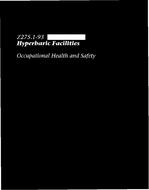Click here to purchase
1. Scope
1.1
General
1.1.1
This Standard applies to hyperbaric chambers having as their primary function the subjection of humans to pressure environments exceeding 1 atmosphere absolute, such as those required in diving operations, work under compressed air conditions, medical treatment, training, and research.
1.1.2
This Standard establishes minimum requirements for the design, construction, maintenance, and testing of all hyperbaric chambers.
1.2 Classification of Manned Chambers
1.2.1
Class A – Multiple Occupancy
1.2.1.1
Stationary A multiple-occupancy hyperbaric chamber permanently installed in a vessel, platform, or shore-based facility and fixed to a permanent foundation, this being either the vessel, platform, or building in which it is housed, shall be known as a stationary chamber.
1.2.1.2
Transportable A multiple-occupancy hyperbaric chamber that can be moved to a diving or caisson site to support on-site operations shall be known as a transportable chamber.
1.2.2
Class B – Portable
1.2.2.1
Evacuation A single- or multiple-occupancy hyperbaric chamber that has as its primary function the emergency transportation under pressure of an individual at risk of, or suffering from, a pressure- related ailment shall be known as an evacuation chamber.
1.2.2.2
Monoplace A hyperbaric chamber that is capable of oxygen or air pressurization to a depth not exceeding 20 m (66 ft) for the provision of hyperbaric oxygen therapy, normally for clinical applications only, and located in a health care facility shall be known as a monoplace chamber. Note: Certain configurations of monoplace chambers allow dual occupancy, though they are essentially identical in construction.
1.2.3
Class C – Submersible Compression Chamber (SCC) A hyperbaric chamber that is capable of transporting personnel, at elevated pressures, from the surface to an underwater site and vice versa shall be known as a submersible compression chamber (SCC).
1.3
Hazards In the design, construction, operation, and maintenance of hyperbaric facilities, safety begins with a recognition of the special hazards associated with hyperbaric facilities. (See Appendices A and B for a description of potential hazards.)
Product Details
- Published:
- 01/01/1993
- Number of Pages:
- 55
- File Size:
- 1 file , 4.1 MB
